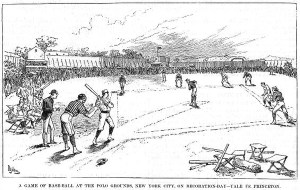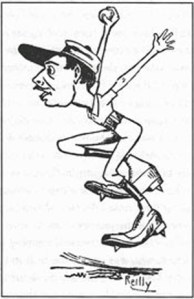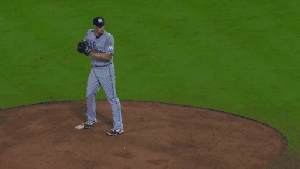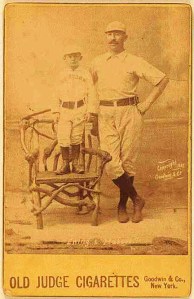Last week, we saw the struggling New York Gothams conclude the first road trip in the 135-year history of the Giants franchise. Overall, the Gothams were on the road for two weeks, from May 11, 1883 to May 25, 1883, winning only one game and losing eight.

The Gothams were scoring an average of four runs per game but allowing an average of 7.5 runs. Hardly winning baseball.
The club gratefully returned to their home in New York City at the original Polo Grounds on 110th street, across from Central Park. As we discussed in the very first part of this series, the New York Gothams were not the only major league ballclub in New York that year. The New York Metropolitans joined the rival American Association that year, and both clubs were owned by the ambitious and wealthy tobacconist John B. Day.
Both the Gothams and Metropolitans played their home games at the Polo Grounds.
May 30, 1883 was Decoration Day (the precursor of Memorial Day) and as one of the few holidays for the public it was traditionally a great day for baseball attendance. Clubs frequently scheduled double headers to capitalize on the higher attendance.
Amazingly on this day, the Gothams and Metropolitans were both scheduled to play simultaneous double headers at the Polo Grounds. Not only that, but Yale University was also scheduled to play Princeton at the Polo Grounds in their celebrated annual match-up.

You might be wondering about the logistics of playing 5 games involving 7 different teams in one day on the same field.
Here’s the scene as described by The New York Times:
“Five games of base ball were played on the Polo Grounds yesterday. The ground was divided by a canvas fence running from One Hundred and Tenth to One Hundred and Twelfth street by which two games were played at one time. The Fifth avenue side of the ground was occupied by the New York (Gothams), Detroit, Yale and Princeton clubs, and the Sixth avenue portion by the Metropolitan, Columbus, and Cincinnati nines. Upward of 10,000 persons witnessed the five games played.”
On May 30, 1883, the Polo Grounds resembled a little league tournament, with games the games being played side by side.
Capri Suns and Orange Slices for everyone!
The first set of games began early in the morning at 9:50 AM. The Metropolitans defeated the Cincinnati Red Stockings (now the Cincinnati Reds), 1-0, behind the stellar pitching of right hander Tim Keefe who was on his way to 41 wins.
The Gothams continued their losing ways falling 5-2 to the Detroit Wolverines in a sloppy game in which all seven runs scored against New York were unearned. Wolverines rookie George Radbourn (cousin of the famous “Old Hoss” Radbourn) was on the mound for what would be his only major league victory.

When the Gothams’ game ended, the Yale and Princeton clubs took the field at 1:00 PM.
Yale fought to a 5-4 victory behind the pitching of the team’s dapper “Jumping” Jack Jones, who became infamous for his utterly unique throwing motion, in which he would jump and throw his fastball in mid-air.

The Metropolitans then played the Columbus Buckeyes at 4:00 PM and after the Yale victory, the Gothams and Detroit Wolverines began their second game at 4:30 PM.
“Smiling” Mickey Welch took the mound for the New York Gothams against “Stump” Weidman of the Wolverines. The clubs traded runs in the first inning and as the fifth inning started, the clubs were deadlocked 1-1.
Detroit scored two runs in the top of the fifth to make the score 3-1. The slumbering Gothams’ bats finally awoke in the bottom half of the inning as they scored four runs. The Gothams added three more runs in the later innings and cruised to an 8-4 victory.
Catcher and lead-off hitter Buck Ewing slugged a triple and a home run, while pitcher Welch helped his own cause with a double and a homer. More importantly, the Gothams snapped their four-game losing streak.
Were the Gothams’ bats finally awake?
It would seem so. They beat the Wolverines again on May 31st by a score of 4-1 and followed that with a 13-7 victory over Detroit on June 1st. Their next foe would be the mighty Chicago White Stockings (now the Chicago Cubs), who had been the 1882 National League pennant winners and arguably the most famous team in baseball.

The club was led by slugging first baseman Cap Anson, perhaps baseball’s greatest star and the first man to get 3,000 hits, and the dazzling and diminutive (5’ 3”) right hander Larry Corcoran. In 1883, the White Stockings were the heavy favorites to repeat as champions.
Yet on June 2, on the strength of 33 hits, including two more home runs for Buck Ewing, the Gothams battered Corcoran and the White Stockings by taking a 22-7 victory. That offensive outburst made 35 runs scored in 2 games.
The White Stockings’ Corcoran rebounded with a 5-2 victory just two days later by shutting down the newly potent Gothams’ offense.
But the Gothams’ bats would not be stopped for long. They closed out their series against Anson and the powerful White Stockings with two more blowout victories, a 10-3 win on June 5 and a 16-8 shellacking on June 7. With 63 runs in 5 games New York was finally playing up to their potential.
The Gothams record was now 10-13 and the team hoped their momentum would continue to build as the 1883 season moved forward.
Add The Sports Daily to your Google News Feed!